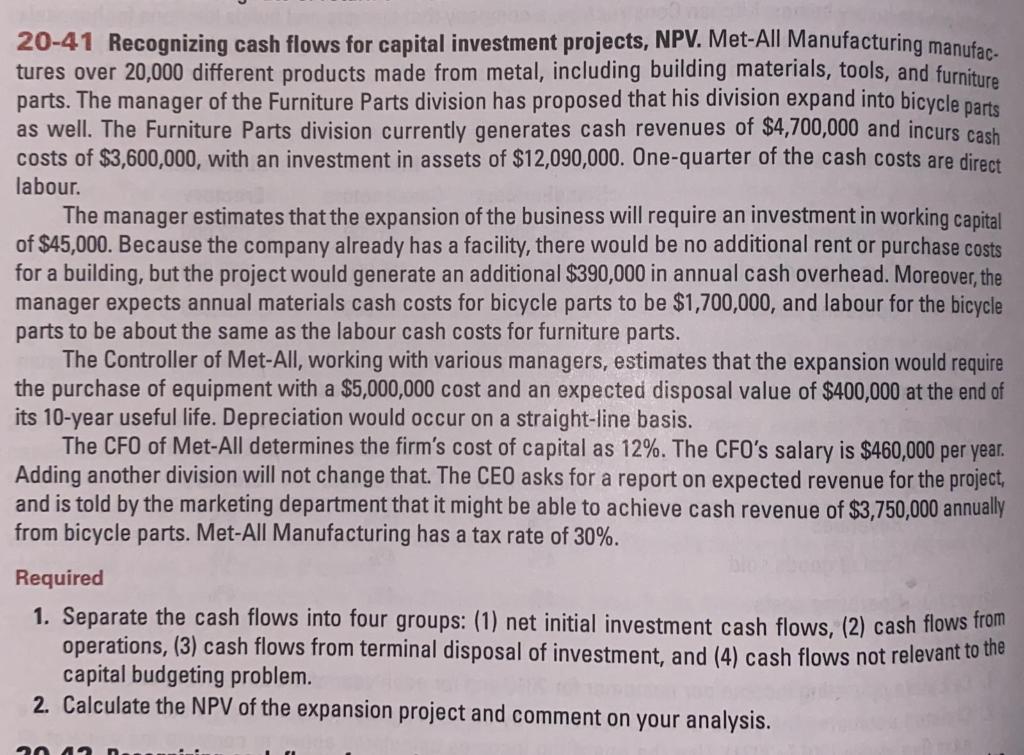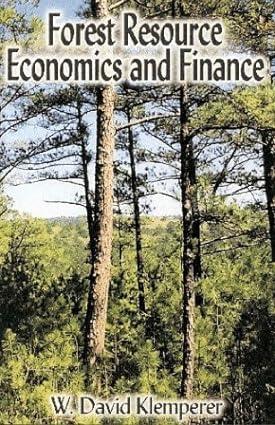
20-41 Recognizing cash flows for capital investment projects, NPV. Met-All Manufacturing manufac- tures over 20,000 different products made from metal, including building materials, tools, and furniture parts. The manager of the Furniture Parts division has proposed that his division expand into bicycle parts as well. The Furniture Parts division currently generates cash revenues of $4,700,000 and incurs cash costs of $3,600,000, with an investment in assets of $12,090,000. One-quarter of the cash costs are direct labour. The manager estimates that the expansion of the business will require an investment in working capital of $45,000. Because the company already has a facility, there would be no additional rent or purchase costs for a building, but the project would generate an additional $390,000 in annual cash overhead. Moreover, the manager expects annual materials cash costs for bicycle parts to be $1,700,000, and labour for the bicycle parts to be about the same as the labour cash costs for furniture parts. The Controller of Met-All, working with various managers, estimates that the expansion would require the purchase of equipment with a $5,000,000 cost and an expected disposal value of $400,000 at the end of its 10-year useful life. Depreciation would occur on a straight-line basis. The CFO of Met-All determines the firm's cost of capital as 12%. The CFO's salary is $460,000 per year. Adding another division will not change that. The CEO asks for a report on expected revenue for the project, and is told by the marketing department that it might be able to achieve cash revenue of $3,750,000 annually from bicycle parts. Met-All Manufacturing has a tax rate of 30%. Required 1. Separate the cash flows into four groups: (1) net initial investment cash flows, (2) cash flows from operations, (3) cash flows from terminal disposal of investment, and (4) cash flows not relevant to the capital budgeting problem. 2. Calculate the NPV of the expansion project and comment on your analysis. 0 An 20-41 Recognizing cash flows for capital investment projects, NPV. Met-All Manufacturing manufac- tures over 20,000 different products made from metal, including building materials, tools, and furniture parts. The manager of the Furniture Parts division has proposed that his division expand into bicycle parts as well. The Furniture Parts division currently generates cash revenues of $4,700,000 and incurs cash costs of $3,600,000, with an investment in assets of $12,090,000. One-quarter of the cash costs are direct labour. The manager estimates that the expansion of the business will require an investment in working capital of $45,000. Because the company already has a facility, there would be no additional rent or purchase costs for a building, but the project would generate an additional $390,000 in annual cash overhead. Moreover, the manager expects annual materials cash costs for bicycle parts to be $1,700,000, and labour for the bicycle parts to be about the same as the labour cash costs for furniture parts. The Controller of Met-All, working with various managers, estimates that the expansion would require the purchase of equipment with a $5,000,000 cost and an expected disposal value of $400,000 at the end of its 10-year useful life. Depreciation would occur on a straight-line basis. The CFO of Met-All determines the firm's cost of capital as 12%. The CFO's salary is $460,000 per year. Adding another division will not change that. The CEO asks for a report on expected revenue for the project, and is told by the marketing department that it might be able to achieve cash revenue of $3,750,000 annually from bicycle parts. Met-All Manufacturing has a tax rate of 30%. Required 1. Separate the cash flows into four groups: (1) net initial investment cash flows, (2) cash flows from operations, (3) cash flows from terminal disposal of investment, and (4) cash flows not relevant to the capital budgeting problem. 2. Calculate the NPV of the expansion project and comment on your analysis. 0 An







